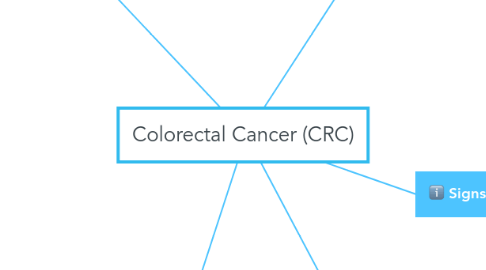
1. Causative factors/Risk factors
1.1. Modifiable Risk Factors
1.1.1. Nutritional Practices: Diets high in red meat and processed meat - incl. meats preserved by preservatives, smoking, curing, or salting - as they contain N-nitroso compounds that can increase nitrogenous residues in the colon and cause DNA damage -red meats also contain high levels of heme iron, which can activate oxidative stress and inflammation in the colon -diets low in fiber
1.1.2. Physical Activity and Obesity: Low physical activity < 4 hours of vigorous activity per week- physical activity increases gut motility which reduces the length of transit time that the bowel lining is exposed to potential mutagens Obesity has decreased insulin sensitivity and greater excess adiposity which influences the amount of adipokines, which are responsible for increased inflammation.
1.1.3. Cigarette Smoking and Alcohol Consumption: Alcoholic beverages leads to reduced genomic DNA methylation in the colon, Smoking aids in the development and growth of adenomatous polyps.
1.2. Nonmodifiable Risk Factors
1.2.1. Personal History of Inflammatory Bowel Disease (IBD): (10 yearh history has up to 30-fold increased risk) Ulcerative Colitis - inflammation of the mucosa of the colon and rectum Chrohn Disease - inflammation of the full thickness of the bowel wall
1.2.2. development of genetic or acquired immunodeficiencies (i.e. immunosuppressive drugs)
1.2.3. Inherited Genetic Risk: Lacking gluthathione-S-transferase (GSTs), enzyme responsible for metabolism of environmental carcinogens and reactive oxygen species (ROS) (see Etiology, chromosomal mutations)
1.2.4. Personal or Family History of Adenomatous Polyps OR Family History of Colorectal Cancer: Neoplastic polyps of the colorectum are precursor lesions of the colorectal cancer
1.2.5. Age: likelihood of the disease increases progressively from age 40
2. Etiology: accumulation of acquired and inherited genetic mutations that transform normal glandular epithelial cells into invasive adenocarcinomas. Oftentimes polyps progress to malginant tumors.
2.1. Chromosomal mutations:
2.1.1. loss to deletion of tumor-suppressor genes such as adenomatous polyposis coli (APC), DCC, and TP53
2.2. Epigenetic Alterations
2.2.1. DNA hypermethylation: the addition of methyl group in the proximal promoter region of the associated genes
2.2.2. epigenetic silencing of APC gene
2.3. Chronic inflammation from bacteria, viruses, autoimmune processes, and toxins plays a large role in CRC progression. Pro-inflammatory mediators such as cytokines, chemokines, ROS, oncogenes, COX-2, 5-lipoxygenase, and matric metalloproteinases (MMPs) promote tumor cell proliferation, invasion, and metastasis.
2.3.1. activation of cyclooxygenase-2 (COX-2), associated with generation of prostaglandins that is responsible for inflammation
2.3.2. adipokines from adipose tissue are a large source of inflammatory modulators specifically adipokine leptin enhances production of tumor necrosis factor-alpha (TNF-α)
3. Screening and Diagnostics
3.1. Fecal occult blood test: Studies of a stool sample for presence of blood. Inflamed polyps are known to cause bleeding. Further studies such as colonoscopy are required to further assess source of the blood.
3.2. Stool DNA test: to analyze several DNA markers that precancerous polyps or cancers cells shed.
3.3. Flexible sigmoidoscopy: a flexible exam of the sigmoid colon and rectum with a sigmoidoscope.
3.3.1. Flexible sigmoidoscopy: a flexible exam of the sigmoid colon and rectum with a sigmoidoscope.
3.4. Imaging: Barium enema X-ray -CT colonography Ultrasound or MRI
3.5. Colonoscopy: an exam of the entire colon which can remove polyps or retrieve biopsies
4. Signs & Symptoms
4.1. GI: Changes in bowel habits including frequency, diarrhea, or constipation -Blood in feces, that makes it appear black -Bright red blood coming from the rectum -Pain and bloating in the abdomen -Feeling of fullness even if you had not had food for a while
4.2. Fatigue or tiredness
4.3. Unexplained weight loss
4.4. Lump in the abdomen or the back
5. Treatment - depends on several factors incl. size, location, cancer stage, recurring or not, and overall health of patient
5.1. Ablation: Utilizes radiofrequency, ethanol, or cryosurgery guided by ultrasound or CT scanning.
5.1.1. Materials
5.1.2. Personnel
5.1.3. Services
5.1.4. Duration
